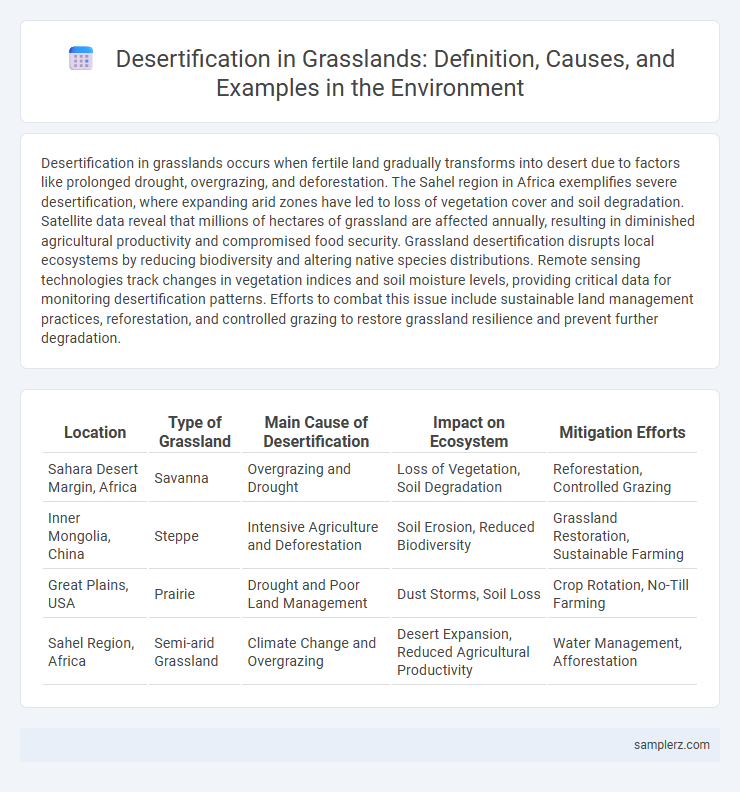Desertification in grasslands occurs when fertile land gradually transforms into desert due to factors like prolonged drought, overgrazing, and deforestation. The Sahel region in Africa exemplifies severe desertification, where expanding arid zones have led to loss of vegetation cover and soil degradation. Satellite data reveal that millions of hectares of grassland are affected annually, resulting in diminished agricultural productivity and compromised food security. Grassland desertification disrupts local ecosystems by reducing biodiversity and altering native species distributions. Remote sensing technologies track changes in vegetation indices and soil moisture levels, providing critical data for monitoring desertification patterns. Efforts to combat this issue include sustainable land management practices, reforestation, and controlled grazing to restore grassland resilience and prevent further degradation.
Table of Comparison
| Location | Type of Grassland | Main Cause of Desertification | Impact on Ecosystem | Mitigation Efforts |
|---|---|---|---|---|
| Sahara Desert Margin, Africa | Savanna | Overgrazing and Drought | Loss of Vegetation, Soil Degradation | Reforestation, Controlled Grazing |
| Inner Mongolia, China | Steppe | Intensive Agriculture and Deforestation | Soil Erosion, Reduced Biodiversity | Grassland Restoration, Sustainable Farming |
| Great Plains, USA | Prairie | Drought and Poor Land Management | Dust Storms, Soil Loss | Crop Rotation, No-Till Farming |
| Sahel Region, Africa | Semi-arid Grassland | Climate Change and Overgrazing | Desert Expansion, Reduced Agricultural Productivity | Water Management, Afforestation |
Overview of Desertification in Grassland Ecosystems
Desertification in grassland ecosystems primarily results from prolonged drought, overgrazing, and unsustainable land management, leading to soil degradation and loss of vegetation cover. Regions such as the Sahel in Africa exemplify severe desertification, where declining rainfall and intensive livestock grazing have transformed productive grasslands into arid zones. This process disrupts biodiversity, reduces carbon sequestration, and threatens the livelihoods of local communities dependent on grassland resources.
Causes of Desertification in Grassland Regions
Overgrazing by livestock removes protective vegetation cover, leading to soil erosion and reduced fertility in grassland regions. Prolonged droughts exacerbate water scarcity, weakening plant resilience and accelerating land degradation. Unsustainable agricultural practices, such as excessive plowing and improper irrigation, disrupt soil structure and contribute significantly to desertification in grassland ecosystems.
Notable Grassland Areas Affected by Desertification
The Sahel region in Africa represents a notable grassland area severely affected by desertification, where expanding arid conditions threaten biodiversity and agricultural productivity. In Central Asia, the Eurasian Steppe faces significant desertification due to overgrazing and climate change, leading to soil degradation and reduced vegetation cover. Australia's extensive grasslands also experience desertification, driven by prolonged droughts and unsustainable land management practices, impacting native species and local communities.
Case Study: Desertification in the Sahel Grasslands
The Sahel region in Africa experiences severe desertification due to a combination of climate change, overgrazing, and unsustainable land management practices. Between 1968 and 1973, prolonged drought events significantly reduced vegetation cover, leading to soil erosion and loss of fertile land. Efforts such as vegetation restoration and sustainable grazing management are critical to combat desertification and support local livelihoods in the Sahel grasslands.
Desertification in the North American Great Plains
Desertification in the North American Great Plains is characterized by soil degradation, loss of native grasses, and reduced agricultural productivity due to prolonged drought and intensive farming practices. Overgrazing by livestock accelerates the decline of topsoil fertility, leading to increased erosion and dust storms reminiscent of the Dust Bowl era during the 1930s. Climate change exacerbates these effects by altering precipitation patterns and increasing temperatures, further stressing the grassland ecosystems.
Australian Grasslands: Patterns of Desertification
Australian grasslands have experienced significant desertification due to prolonged droughts, overgrazing, and climate change, leading to soil degradation and loss of vegetation cover. The transformation of fertile grassland into arid, barren land disrupts local ecosystems and reduces biodiversity. Land management practices emphasizing sustainable grazing and reforestation are critical to mitigating these desertification patterns.
The Impact of Overgrazing on Grassland Desertification
Overgrazing significantly accelerates grassland desertification by stripping vegetation cover, which destabilizes soil structure and reduces moisture retention. In regions such as the Sahel and parts of Central Asia, intensive livestock grazing has led to severe land degradation, causing a decline in biodiversity and productivity. The loss of grasses exposes soil to wind erosion, further exacerbating desertification and diminishing the land's capacity to support agriculture and local ecosystems.
Drought and Its Role in Grassland Degradation
Drought significantly accelerates desertification in grasslands by reducing soil moisture and plant biomass, leading to decreased vegetation cover and increased soil erosion. Prolonged dry spells weaken root systems, impairing the grassland's ability to recover and promoting the expansion of barren, desert-like areas. Critical regions such as the Sahel in Africa and the Great Plains in the United States illustrate how recurrent drought events intensify grassland degradation and threaten local ecosystems.
Socioeconomic Consequences of Grassland Desertification
Grassland desertification leads to significant socioeconomic consequences, including reduced agricultural productivity and loss of livestock, which directly impact the livelihoods of rural communities dependent on grazing. The decline in vegetation cover exacerbates soil erosion, diminishing land fertility and forcing migration to urban areas in search of employment. This environmental degradation also increases poverty rates and food insecurity among affected populations, straining local economies and social structures.
Solutions and Restoration Efforts for Grassland Desertification
Restoration efforts for grassland desertification emphasize reseeding native grasses and implementing controlled grazing practices to enhance soil stability and biodiversity. Techniques such as contour plowing and the establishment of windbreaks reduce soil erosion and improve water retention in arid regions. Community-led land management projects and the use of drought-resistant plant species demonstrate effective solutions to reverse desertification trends in degraded grasslands.

example of desertification in grassland Infographic
 samplerz.com
samplerz.com